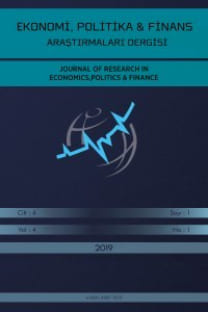G7 Ülkelerinde Kayıtdışı Ekonomiye Yol Açan Faktörler
Kayıtdışı Ekonomi, MIMIC Model, G7 Ülkeleri
Factors for the Underground Economy in G7 Countries
Underground Economy, MIMIC Model, G7 Countries,
___
- Bose, N., Capasso, S. and Wurm, M. A. (2012). The impact of banking development on the size of shadow economies. Journal of Economic Studies, 32(6), 620-638. https://doi.org/10.1108/01443581211274584
- Breusch, T. (2005). Estimating the underground economy using MIMIC models (University Library of Munich Econometrics Working Paper No. 0507003). Retrieved from https://econwpa.wustl.edu/eps/em/papers/0507/0507003.pdf
- Buehn, A. and Schneider, F. (2012). Shadow economies around the world: Novel insights, accepted knowledge, and new estimates. International Tax and Public Finance, 19, 139-171. https://doi.org/10.1007/s10797-011-9187-7
- Chong, A. and Gradstein, M. (2004). Inequality, institutions and informality (Inter-American Development Bank IDB Working Paper No. 427). Retrived from Retrieved from https://poseidon01.ssrn.com/delivery.php?ID=796114123085008074113103102094083092038004029014029041005011004117122112076031004093006013067115119110092099102112102104115005015006118068113123070101084072020106009003&EXT=pdf
- Dey, C., Russell, S. and Thomson, I. (2011). Exploring the potential of shadow accounts in problematizing institutional conduct. In A. Ball ve A. S. Osbourne (Eds.), Social accounting and public management: Accountability for the common good (pp. 1-16). London: Routledge.
- Gasparėnienė, L. and Remeikienė, R. (2016). The methodologies of shadow economy estimation in the world and in Lithuania: Whether the criterions fixing digital shadow are included?. Procedia Economics and Finance, 39, 753-760. https://doi.org/10.1016/S2212-5671(16)30277-5
- Hassan, M. and Schneider, F. (2016). Size and development of the shadow economies of 157 countries worldwide: Updated and new measures from 1999 to 2013 (IZA Discussion Paper Series No. 10281). Retrived from https://ftp.iza.org/dp10281.pdf
- Im, K. S., Pesaran, M. H. and Shin, Y. (2003). Testing for unit roots in heterogeneous panels. Journal of Econometrics, 115, 53–74. Retrived from www.jstore.org
- Juškienė, G. (2015). Overview of the methods used to ensure exhaustiveness the national accounts of Lithuania (Workshop on Measurement of the Non-Observed Economy Sochi). Retrieved from https://www.oecd.org/std/na/2069700.pdf
- Krstič, G. and Sanfey, P. (2010). Earnings inequality and the informal economy: Evidence from Serbia (European Bank for Reconstruction and Development Working Paper No. 114). Retrieved from https://www.ebrd.com/downloads/research/economics/workingpapers/wp0114.pdf
- Levin, A., Lin, C. F. and Chu, C. S. J. (2002). Unit root tests in panel data: Asymptotic and finite-sample properties. Journal of Econometrics, 108, 1–24. www.jstore.org
- Quirk, P. J. (1998). Macroeconomic implications of money laundering (IMF Working Paper No. 96:66). Retrieved from https://www.elibrary.imf.org/doc/IMF001/04385-9781451962123/04385-9781451962123/Other_formats/Source_PDF/04385-9781455295791. pdf
- Rigdon, E. (2004). What is structural equation modeling? (GSU Working Paper No. 12). Retrieved from http://www2.gsu.edu/~mkteer/
- Schneider, F. (2007). Shadow economies and corruption all over the world: new estimates for 145 countries (CESifo Working Paper No. 1806). Retrieved from (CESifo Working Paper No. 1806). Retrieved from https://www.researchgate.net/publication/5141532_ Shadow_Economies_and_Corruption_All_Over_the_World_What_Do_We_Really_Know
- Schneider, F. (2017). Implausible large differences in the sizes of the underground economies highly developed European countries? A comparison of different estimation (CESifo Working Paper Series No. 6522). Retrieved from https://www.econ.jku.at/members/Schneider /files/publications/2017/EstShadEc_OECDCountries.pdf
- Schneider, F. and Buehn, A. (2016). Estimating the size of the shadow economy: Methods, problems and open questions (IZA Discussion Paper Series No. 9820). Retrieved from https://ftp.iza.org/dp9820.pdf
- Schneider, F. and Enste, D. (2000). Shadow economies: Size, causes, and consequences. Journal of Economic Literature, 38, 77-114. https://doi.org/10.1257/jel.38.1.77
- Schneider, F. and Kearney, A. T. (2013). The shadow economy in Europe (VISA Sponsored Working Paper). Retrieved from http://feelingeurope.eu/Pages/Shadow_Economy_in_Europe.pdf
- Schneider, F., Raczkowski, K. and Mróz, B. (2015). Shadow economy and tax evasion in the EU. Journal of Money Laundering Control, 18(1), 34-51. https://doi.org/10.1108/JMLC-09-2014-0027
- Schneider, F. and Williams, C. (2016). The shadow economy. London: IEA Publications.
- Tregidga, H. (2017). Speaking truth to power: Analysing shadow reporting as a form of shadow accounting. Accounting, Auditing & Accountability Journal, 30(3), 510-533. https://doi.org/10.1108/AAAJ-01-2015-1942
- Williams, C. C. (2009). Rationales for outsourcing domestic services to off-the-books workers. Journal of Economic Studies, 36(4), 343-354. https://doi.org/10.1108/01443580910973565
- Williams, C. C. (2010). Out of the shadows: explaining the undeclared economy in Baltic countries. Journal of Baltic Studies, 41(1), 3-22. https://doi.org/10.1080/01629770903525282
- Williams, C. C. and Nadin, S. (2012). Tackling entrepreneurship in the informal economy: Evaluating the policy options. Journal of Entrepreneurship and Public Policy, 1(2), 111-124. https://doi.org/10.1108/20452101211261408
- Winkelried, D. (2005). Income distribution and the size of the informal sector (Social Science Research Network Research Paper). Retrived from https://doi.org/10.2139/ssrn.777144
- World Bank. (2018). World Bank Development Indicators [Dataset]. Retrieved from https://data.worldbank.org/
- Wu, J. and Yang, H. (2016). More on the unbiased ridge regression estimation. Statistical Papers, 57, 31–42. https://doi.org/10.1007/s00362-014-0637
- Yayın Aralığı: Yılda 4 Sayı
- Başlangıç: 2016
- Yayıncı: Ersan ERSOY
BİST Yıldız Endeksinde İşlem Gören Firmaların Kârlılıklarına Etki Eden Çalışma Sermayesi Faktörleri
Berk YILDIZ, Türker İlker İlker DENİZ
İnternet Tabanlı Yatırımcı İlişkileri Analizi: Borsa İstanbul Ulaştırma Sektöründe Bir İnceleme
Küreselleşmenin Ekolojik Ayakizi Üzerindeki Etkileri: Türkiye Örneği
Gemi Sahiplerinin Filo Kapasitesi Ayarlama Kararlarında Faiz Oranlarının Rolü
Abdullah AÇIK, Halil Hüseyin İshak KESİKTAŞ, Sadık Özlen BAŞER
Türkiye’deki Avrupa Şüpheciliğini Yeniden Düşünmek: Hükümet, Muhalefet ve Kamuoyu
Türkiye’de Enerji Arz Güvenliği Riskinin Makroekonomik Etkileri: Vektör Hata Düzeltme Modeli
Toplam Faktör Verimliliği Artışı ve Demografi: Türkiye Örneği
Volkan ÇETİN, H. Serkan AKILLI
Gambiya'da İç Borçların Özel Sektör Yatırımları Üzerindeki Etkileri: ARDL Yaklaşımı
